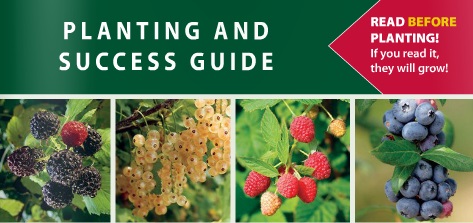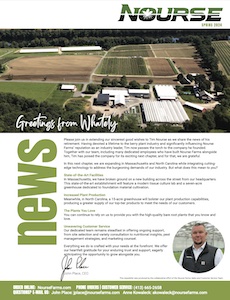Raspberries are a high-value crop much in demand. Fall bearing raspberries are an excellent complement to fall crops like apples and pumpkins. Here we focus on the basics for producing these raspberries, which are gaining popularity.
Site Preparation
- Avoid a site where previous crops have included brambles, strawberries, potatoes, tomatoes, eggplant, or peppers. Destroy all wild raspberries and other brambles within 500 to 1,000 feet of your planting site.
- We advise taking soil samples to get a read on your pH, percentage of organic matter, and overall fertility to make changes well in advance of planting. Our recommendations are a pH in the 6.5–6.8 range with minimum 2–3% organic matter.
- Planting on raised beds is highly recommended to improve soil drainage in the rooting zone, particularly on heavier soils.
- Selecting a site with a gentle slope (3–4%) and good air drainage will also promote faster drying of foliage, flowers, and fruit. This can reduce the duration and frequency of disease infection periods. Recommended plant spacing is 18–24 inches in the row and 10–12 feet between the rows.
- Drip Irrigation is an essential component to successful raspberry production. Plants generally require 1–2 inches of water per week during the growing season and 2–3 inches per week during harvest. We suggest having your local irrigation sales company review your field layout for the best recommendation.
Choosing a Variety
One of the most important decisions a grower can make is the choice of varieties for their operation. U-Pick growers look at flavor and season extension as priorities. Productivity, ease-of-picking and longer shelf-life potential are important for fresh market sales. Ripening time is also an important consideration both for areas that get high late summer temperatures or are prone to early hard frost. Please see our catalog or noursefarms.com for variety descriptions. Below is a chart of our primocane raspberry varieties and ripening time.

Planting & Fertilization
- We recommend planting early in the spring when soil temperatures are in the 45–50-degree range.
- Keeping roots at this depth and not too deep allows easier sucker development from roots.
- Consider using a product such as Agri-gelTM to help support plants through dry periods.
- Do not fertilize at planting. Earlier in this article, we recommend a soil sample the previous year to determine nutritional needs. If needed, apply 20–35 pounds actual nitrogen per acre based on soil type. Primocane fruiting varieties can benefit from split fertilizer applications in early spring and again in late May or June.
- Using mulches during the first year for the establishment of raspberry plants can help manage weeds, reduce or eliminate herbicides, maintain soil moisture for the new plants, and maximize the growth of the new planting.
Tunnel Production
High tunnel raspberry production continues to be a hot topic in the industry. We have had excellent success in using high tunnels in our bramble production. High tunnels can lengthen the fall picking season on primocanes. In reverse, if double cropping, the floricane crop can be even earlier under high tunnels.
Trellising & Pruning
We recommend all brambles, including red raspberries, be supported by trellis. A trellis keeps canes upright and fruit off the ground, making picking easier. Trellising also maintains good aeration throughout the planting season which helps with disease control. We have been successful using a T-bar trellis with 2 T-bars – one at 3 feet and one at 4 feet above the ground. See our website for diagrams.
Pruning time and manner depend on whether you are fruiting on the primocanes only or looking at double cropping. Most fall-bearers will produce the best crop if canes are cut down each year and only allowed to fruit in the fall. For fall production only, prune or mow all the canes to the ground, leaving little or no stubble in late winter/early spring. Timing is also very important: if canes are cut too early in the fall or too late in spring, new primocanes will be weak. Ideal timing is
December—February.
Double cropping means fruiting on the first year primocanes in addition to floricanes the second year. In order to develop the 2 crops, the planting must be pruned as summer bearing varieties. When allowed to stand through the winter, a second crop is produced. This second crop is produced early the following summer, lower on those over-wintered canes. After harvesting the summer crop, cut the canes to the ground, leaving the new primocanes to produce the fall crop.
Pest Management
Good weed control during the first year is essential. Raspberry plants are sensitive to most herbicides during the first few months after planting. Research has shown that applying a clean straw mulch (4 inches deep) to newly planted raspberry plants provides good weed control. We recommend the straw be chopped to form a tight layer over the top of the soil and be less affected by wind removing it. If plastic mulches are used, they need to be removed after the first growing season to reduce the threat from Phytophthora. We do not recommend bark mulch. Like any crop, a variety of pests need to be managed to maximize yields, fruit quality, and extend the life of your planting. Based on experience, growers should be concerned with:
-
Spotted Wing Drosophila (SWD)
-
Phytophthora Root Rot
-
Botrytis Fruit Rot (Grey Mold)
-
Aphids
-
Yellow (Late or Fall) Rust
-
Mites
Please review past newsletters on our website at NourseFarms.com, or contact your local cooperative extension office for specifics on possible controls.



